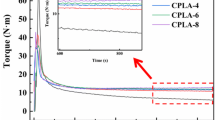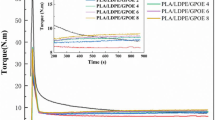Abstract
Poly(lactide acid) (PLA) foams have shown considerable promise as eco-friendly alternatives to nondegradable plastic foams, such as polystyrene (PS) foams. Nevertheless, PLA foam typically suffers from low heat-resistance and poor cellular structure stemming from its inherent slow crystallization rate and low melt strength. In this study, a high-performance PLA foam with well-defined cell morphology, exceptional strength and enhanced heat-resistance was successfully fabricated via a core-back microcellular injection molding (MIM) process. Differential scanning calorimetry (DSC) results revealed that the added hydrazine-based nucleating agent (HNA) significantly increased the crystallization temperature and accelerated the crystallization process of PLA. Remarkably, the addition of a 1.5 wt% of HNA led to a significant reduction in PLA’s cell size, from 43.5 µm to 2.87 µm, and a remarkable increase in cell density, from 1.08×107 cells/cm3 to 2.15×1010 cells/cm3. This enhancement resulted in a final crystallinity of approximately 55.7% for the PLA blend foam, a marked improvement compared to the pure PLA foam. Furthermore, at 1.5 wt% HNA concentration, the tensile strength and tensile toughness of PLA blend foams demonstrated remarkable improvements of 136% and 463%, respectively. Additionally, the Vicat softening temperature of PLA blend foam increased significantly to 134.8 °C, whereas the pure PLA foam exhibited only about 59.7 °C. These findings underscore the potential for the preparation of lightweight injection-molded PLA foam with enhanced toughness and heat-resistance, which offers a viable approach for the production of high-performance PLA foams suitable for large-scale applications.
Similar content being viewed by others
Data Availability Statement
The data that support the findings of this study are available from the corresponding author upon reasonable request. The author’s contact information: wanglong@nimte.ac.cn (L.W.), wgzheng@nimte.ac.cn (W.G.Z.)
References
Doroudiani, S.; Park, C. B.; Kortschot, M. T. Processing and characterization of microcellular foamed high-density polythylene/isotactic polypropylene blends. Polym. Eng. Sci. 1998, 38, 1205–1215.
Yang, J.; Xie, J.; Ji, K.; Wang, X.; Jiao, X.; Xu, Z.; Zhao, P. Microcellular injection molding of polyether-ether-ketone. Polymer 2022, 251, 124866.
Zhao, J.; Zhao, Q.; Wang, C.; Guo, B.; Park, C. B.; Wang, G. High thermal insulation and compressive strength polypropylene foams fabricated by high-pressure foam injection molding and mold opening of nano-fibrillar composites. Mater. Des. 2017, 131, 1–11.
Hou, J.; Zhao, G.; Wang, G.; Dong, G.; Xu, J. A novel gas-assisted microcellular injection molding method for preparing lightweight foams with superior surface appearance and enhanced mechanical performance. Mater. Des. 2017, 127, 115–125.
Wang, G. L.; Zhao, J. C.; Wang, G. Z.; Zhao, H. B.; Lin, J.; Zhao, G. Q.; Park, C. B. Strong and super thermally insulating in-situ nanofibrillar PLA/PET composite foam fabricated by high-pressure microcellular injection molding. Chem. Eng. J. 2020, 390, 124520.
Rhim, J. W.; Park, H. M.; Ha, C. S. Bio-nanocomposites for food packaging applications. Prog. Polym. Sci. 2013, 38, 1629–1652.
Ju, Q.; Tang, Z. P.; Shi, H. D.; Zhu, Y. F.; Shen, Y. C.; Wang, T. W. Thermoplastic starch based blends as a highly renewable filament for fused deposition modeling 3D printing. Int. J. Biol. Macromol. 2022, 219, 175–184.
Wang, Y. Y.; Wang, Y.; Zhu, W. B.; Lan, D.; Song, Y. M. Flexible poly(butylene adipate-co-butylene terephthalate) enabled high-performance polylactide/wood fiber biocomposite foam. Ind. Crops Prod. 2023, 204, 117381.
Wu, M.; Ren, Q.; Zhu, X.; Li, W.; Luo, H.; Wu, F.; Wang, L.; Zheng, W.; Cui, P.; Yi, X. Super toughened blends of poly(lactic acid) and poly(butylene adipate-co-terephthalate) injection-molded foams via enhancing interfacial compatibility and cellular structure. Int. J. Biol. Macromol. 2023, 245, 125490.
Zhao, H.; Bian, Y.; Li, Y.; Dong, Q.; Han, C.; Dong, L. Bioresource-based blends of poly(3-hydroxybutyrate-co-4-hydroxybutyrate) and stereocomplex polylactide with improved rheological and mechanical properties and enzymatic hydrolysis. J. Mater. Chem. A 2014, 2, 8881–8892.
Najafi, N.; Heuzey, M. C.; Carreau, P. J.; Therriault, D.; Park, C. B. Mechanical and morphological properties of injection molded linear and branched-polylactide (PLA) nanocomposite foams. Eur. Polym. J. 2015, 23, 455–465.
Tang, Y. J.; Wang, Y. Q.; Chen, S. H.; Wang, X. D. Fabrication of low-density poly(lactic acid) microcellular foam by self-assembly crystallization nucleating agent. Polym. Degrad. Stabil. 2022, 198, 109891.
Wang, L.; Hikima, Y.; Ishihara, S.; Ohshima, M. Fabrication of lightweight microcellular foams in injection-molded polypropylene using the synergy of long-chain branches and crystal nucleating agents. Polymer 2017, 128, 119–127.
Ren, Q.; Wu, M. H.; Wang, L.; Zheng, W. E.; Hikima, Y.; Semba, T.; Ohshima, M. Light and strong poly(lactic acid)/cellulose nanofiber nanocomposite foams with enhanced rheological and crystallization property. J. Supercrit. Fluids 2022, 190, 105758.
Ren, Q.; Wu, M. H.; Wang, L.; Zheng, W. E.; Hikima, Y.; Semba, T.; Ohshima, M. Cellulose nanofiber reinforced poly(lactic acid) with enhanced rheology, crystallization and foaming ability. Carbohydr. Polym. 2022, 286, 119320.
Zhu, X.; Ren, Q.; Li, W.; Wu, M.; Weng, Z.; Wang, J.; Zheng, W.; Wang, L. In situ nanofibrillar fully-biobased poly(lactic acid)/poly(ethylene 2,5-furandicarboxylate) composites with promoted crystallization kinetics, mechanical properties, and heat resistance. Polym. Degrad. Stabil. 2022, 206, 110172.
Wang, Y.; Guo, F. M.; Liao, X.; Li, S. J.; Yan, Z. H.; Zou, F. F.; Peng, Q. Y.; Li, G. X. Migri-expansion-ratio PLLA/PDLA/HNT composite foams with good thermally insulating property and enhanced compression performance via supercritical CO2. Int. J. Biol. Macromol. 2023, 236, 123961.
Liao, X.; Nawaby, A. V.; Naguib, H. E. Porous poly(lactic acid) and PLA-nanocomposite structures. J. Appl. Polym. Sci. 2012, 124, 585–594.
Wu, Y.; Zhang, S.; Han, S. Q.; Yu, K. S.; Wang, L. Y. Regulating cell morphology of poly(lactic acid) foams from microcellular to nanocellular by crystal nucleating agent. Polym. Degrad. Stabil. 2022, 204, 110117.
Jain, S.; Misra, M.; Mohanty, A. K.; Ghosh, A. K. heermal, mechanical and rheological behavior of poly(lactic acid)/talc composites. J. Polym. Environ. 2012, 20, 1027–1037.
Piekarska, K.; Sowinski, P.; Piorkowska, E.; Ul Haque, M. M.; Pracella, M. Structure and properties of hybrid PLA nanocomposites with inorganic nanofillers and cellulose fibers. Compos. Part A: Appl. Sci. Manuf. 2016, 82, 34–41.
Girdthep, S.; Limwanich, W.; Punyodom, W. Non-isothermal cold crystallization, melting, and moisture barrier properties of silver-loaded kaolinite filled poly(lactic acid) films. Mater. Chem. Phys. 2022, 276, 125227.
Ouchiar, S.; Stoclet, G.; Cabaret, C.; Georges, E.; Smith, A.; Martias, C.; Addad, A.; Gloaguen, V. Comparison of the influence of talc and kaolinite as inorganic fillers on morphology, structure and thermomechanical properties of polylactide based composites. Appl. Clay Sci. 2015, 116, 231–240.
Clarkson, C. M.; Azrak, S. M. E.; Schueneman, G. T.; Snyder, J. F.; Youngblood, J. P. Crystallization kinetics and morphology of small concentrations of cellulose nanofibrils (CNFs) and cellulose nanocrystals (CNCs) melt-compounded into poly(lactic acid) (PLA) with plasticizer. Polymer 2020, 187, 122101.
Zhang, Y. C.; Duvigneau, J.; Sui, X. F.; Vancso, G. J. Foaming of polylactic acid/cellulose nanocrystal composites: pickering emulsion templating for high-homogeneity filler dispersions. ACS Appl. Polym. Mater. 2022, 4, 111–120.
Soleimanpour, A.; Khonakdar, H.; Mousavi, S. R.; Hemmati, F.; Arjmand, M.; Arnhold, K.; Reuter, U.; Khonakdar, H. A. Dynamic crystallization kinetics and morphology of carbonaceous nanofillers-reinforced poly(lactic acid) foams. Thermochim. Acta 2022, 716, 179308.
Kim, S. Y.; Shin, K. S.; Lee, S. H.; Kim, K. W.; Youn, J. R. Unique crystallization behavior of multi-walled carbon nanotube filled poly(lactic acid). Fibers Polym. 2010, 11, 1018–1023.
Ren, Q.; Li, W.; Cui, S.; Ma, W.; Zhu, X.; Wu, M.; Wang, L.; Zheng, W.; Semba, T.; Ohshima, M. Improved thermal insulation and compressive property of bimodal poly(lactic acid)/cellulose nanocomposite foams. Carbohydr. Polym. 2023, 202, 120419.
Nam, J. Y.; Okamoto, M.; Okamoto, H.; Nakano, M.; Usuki, A.; Matsuda, M. Morphology and crystallization kinetics in a mixture of low-molecular weight aliphatic amide and polylactide. Polymer 2006, 47, 1340–1347.
Niu, D.; Shen, T.; Xu, P.; Yu, M.; Liu, T.; Yang, W.; Wang, Z.; Ma, P. Enhanced crystallization, heat resistance and transparency of poly(lactic acid) with self-assembling bis-amide nucleator. Int. J. Biol. Macromol. 2023, 234, 123584.
Bai, H.; Huang, C.; Xiu, H.; Zhang, Q.; Fu, Q. Enhancing mechanical performance of polylactide by tailoring crystal morphology and lamellae orientation with the aid of nucleating agent. Polymer 2014, 55, 6924–6934.
Gao, X.; Qi, S.; Yang, B.; Su, Y.; Li, J.; Wang, D. Synergistic effect of plasticizer and nucleating agent on crystallization behavior of polylactide during fused filament fabrication. Polymer 2021, 215, 123426.
Tang, Y. J.; Li, Z. L.; Chen, S. H.; Wang, X. D. The synergistic effect of polytetrafluoroethylene in-situ fibrillation and dibenzoyl sebacate hydrazide on the crystallization and foaming behavior of poly(lactic acid). Int. J. Biol. Macromol. 2022, 221, 523–535.
Zhao, X.; Yu, J.; Liang, X.; Huang, Z.; Li, J.; Peng, S. Crystallization behaviors regulations and mechanical performances enhancement approaches of polylactic acid (PLA) biodegradable materials modified by organic nucleating agents. Int. J. Biol. Macromol. 2023, 233, 123581.
Xu, T.; Zhang, A.; Zhao, Y.; Han, Z.; Xue, L. Crystallization kinetics and morphology of biodegradable poly(lactic acid) with a hydrazide nucleating agent. Polym. Test. 2015, 45, 101–106.
Li, C. H.; Luo, S. S.; Wang, J. F.; Wu, H.; Guo, S. Y.; Zhang, X. Conformational regulation and crystalline manipulation of PLLA through a self-assembly nucleator. Biomacromolecules 2017, 18, 1440–1448.
Wang, L.; Ando, M.; Kubota, M.; Ishihara, S.; Hikima, Y.; Ohshima, M.; Sekiguchi, T.; Sato, A.; Yano, H. Effects of hydrophobic-modified cellulose nanofibers (CNFs) on cell morphology and mechanical properties of high void fraction polypropylene nanocomposite foams. Compos. Part A: Appl. Sci. Manuf. 2017, 98, 166–173.
Luo, F.; Geng, C.; Wang, K.; Deng, H.; Chen, F.; Fu, Q.; Na, B. New understanding in tuning toughness of β-polypropylene: the role of β-nucleated crystalline morphology. Macromolecules 2009, 42, 9325–9331.
Bai, H.; Zhang, W.; Deng, H.; Zhang, Q.; Fu, Q. Control of crystal morphology in poly(l-lactide) by adding nucleating agent. Macromolecules 2011, 44, 1233–1237.
Leung, S. N.; Park, C. B.; Xu, D.; Li, H.; Fenton, R. G. Computer simulation of bubble-growth phenomena in foaming. Ind. Eng. Chem. Res. 2006, 45, 7823–7831.
Wang, C.; Shaayegan, V.; Ataei, M.; Costa, F.; Han, S.; Bussmann, M.; Park, C. B. Accurate theoretical modeling of cell growth by comparing with visualized data in high-pressure foam injection molding. Eur. Polym. J. 2019, 119, 189–199.
Lin, H.; Chen, Y.; Gao, X. R.; Xu, L.; Lei, J.; Zhong, G. J.; Li, Z. M. Transparent, heat-resistant, ductile, and self-reinforced polylactide through simultaneous formation of nanocrystals and an oriented amorphous phase. Mcoromeleceles 2023, 56, 2454–2464.
Ding, W. D.; Jahani, D.; Chang, E.; Alemdar, A.; Park, C. B.; Sain, M. Development of PLA/cellulosic fiber composite foams using injection molding: crystallization and foaming behaviors. Compos. Part A Appl. Sci. Manuf. 2016, 83, 130–139.
Péter, T.; Litauszki, K.; Kmetty, Á. Improving the heat deflection temperature of poly(lactic acid) foams by annealing. Polym. Degrad. Stab. 2021, 190, 109646.
Tábi, T.; Hajba, S.; Kovács, J. G. Effect of crystalline forms (a′ and a) of poly(lactic acid) on its mechanical, thermo-mechanical, heat deflection temperature and creep properties. Eur. Polym. J. 2016, 82, 232–243.
Chai, J. L.; Wang, G. L.; Zhang, A. M.; Li, S.; Zhao, J. C.; Zhao, G. Q.; Park, C. B. Ultra-ductile and strong in-situ fibrillated PLA/PTFE nanocomposites with outstanding heat resistance derived by CO2 reeet-merit. Compos. Part A Appl. Sci. Manuf. 2022, 155, 106849.
Acknowledgments
This work was financially supported by the National Natural Science Foundation of China (No. 52003280), the Zhejiang Provincial Natural Science Foundation of China (No. LQ21B040003), the S&T Innovation 2025 Major Special Programme of Ningbo (No. 2021Z052), and the Chinese Academy of Sciences Pioneer Hundred Talents Program.
Author information
Authors and Affiliations
Corresponding authors
Ethics declarations
The authors declare no interest conflict.
Rights and permissions
About this article
Cite this article
Bing, XH., Ma, WY., Wu, MH. et al. Lightweight, Strong and High Heat-Resistant Poly(lactide acid) Foams via Microcellular Injection Molding with Self-Assembly Nucleating Agent. Chin J Polym Sci (2024). https://doi.org/10.1007/s10118-024-3088-6
Received:
Accepted:
Published:
DOI: https://doi.org/10.1007/s10118-024-3088-6




